
A conventional cube is a pile of the best cards in Magic. Unconventional cubes stray from this in accordance to the theme that defines them, but are the same in spirit. You know who likes things that are the best? Spike does. Cube drafting is a format that's incredibly Spike-friendly. This is good to a point, but once in a while it's nice to let your Timmy or Johnny streak come out to play.
In this article I'm going to share the work I did to make my cube more inviting to Timmy and Johnny. My cube is all uncommons, but aside from power-level differences it plays much like a conventional cube. In fact, I hope you'll be able to take something away from this article regardless of the particulars of your cube. The specific cards I discuss will not be the most important thing to worry about; I trust you to be able to come up with analogies in your own cube. What's key is a familiarity with the dynamics of your cube and the predispositions of your players.
I'm writing to those of you who have cubes, enjoy playing them, or even just are interested in the art and science of cube design. If you don't know what a cube is, click here for a two-minute YouTube rundown by Mark Rosewater, head designer of Magic. Also key will be the player psychographic profiles Timmy, Johnny, and Spike. If those names don't mean anything to you, read this piece, also by Mark Rosewater. What helpful guy!
I suspect you didn't read the article, even if you should have. Here are the CliffsNotes.
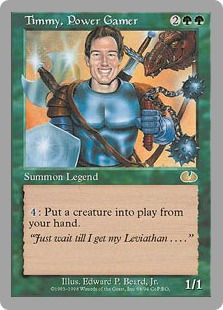
this picture must be included with any player psychographic discussion
Johnny plays trickily. Every time you look at a card and decide it's useless because winning with it would have to be hilariously convoluted, that's a Johnny card. Johnny uses the game as a way to test his cleverness. He's the one who will play Forbidden Orchard and Repercussion just so that he can Radiate a Lightning Bolt for the win.
Spike plays to win, or, perhaps more accurately, to demonstrate his aptitude. He prefers cards that are good and plays whatever deck it is that he thinks will be best at winning. High profile powerhouses in any format are Spike cards, I guess, so examples could include Tarmogoyf and Bitterblossom.
There's probably one of these that you relate most strongly to, though you may have traits corresponding to more than one profile. For example, I'm a Timmy with hints of Spike; I play to win but I'm here to play.
(There are also Vorthos and Melvin, who I won't really talk about. Melvin finds the game mechanically interesting; he's more concerned with cube design than with actually playing it. It's not obvious to me that Vorthos, the flavor enthusiast, would have any particular interest in cubes.)
As one final aside, I want to give you some feel of my cube, since that's what I'll be using as a demonstration. Rather than providing an exhaustive list (which you can find on the cube forum if you're so inclined), I'll just have you take a gander at a handful of the stronger cards in the cube.
White: Cloudgoat Ranger, Ghostly Prison, Swords to Plowshares
Blue: Crystal Shard, Fact or Fiction, Control Magic
Black: Arrogant Bloodlord, Barter in Blood, Shriekmaw
Red: Avalanche Riders, Firemaw Kavu, Fireball
Green: Eternal Witness, Harmonize, Deadwood Treefolk
Multicolor: Bloodbraid Elf, Behemoth Sledge, Cauldron Dance, Psychatog
In essence it's the strongest uncommons in Magic, though some (Clamp, Sol Ring, Mana Drain, and a few others) are omitted for balance reasons.
Like a conventional cube, mine supports aggro, midrange, and control strategies. There are a few quirky choices, such as the five Honden cycle, but overall it's straightforward. For a detailed report you can check out my first article; otherwise you can take my word that it's Spike-friendly. Until recently there wasn't much support for Timmy and Johnny. Timmy had Flame Wave, I guess, and it took a Johnny to care enough about Fusion Elemental to try to play him. That's about it.
Mixing Up the Johnny Juice
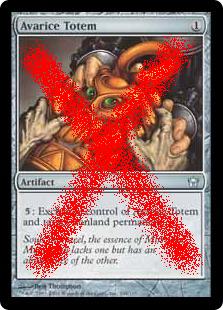
This may sound strange to some of you, particularly those with conventional cubes. Sure, you'll rotate in new cards as sets are released but often you think of a cube as being statically built from the best cards. Cards don't become any weaker by being played, so Spike doesn't see any reason to take a card out of a cube unless a better card comes along to replace it. Johnny, on the other hand, is always happy to be provided with a new puzzle.
Rotating cards in and out will be a concern for the future. The first trick was even tracking down the first round of Johnny cards for the cube. If I were clever, I would have some story about how I came up with them; maybe I could claim I have an encyclopedic knowledge of obscure uncommons, or perhaps I dug through old combo decks I had sitting around. In truth I scrolled through Gatherer looking for cards with lots of text on them.
Avarice Totem was the first find. It seems fun, I thought. Sadly, even at the best of times it's completely unplayable. Ramp can do better (more on ramp later in the article) and nobody else can reliably get to the ten mana required to pull off any shenanigans. It was quickly cut.
My second attempt was Power Conduit, which showed promise. It plays well with dozens of cards already in the cube; storage counters and fade counters exist on a handful of cards each. Furthermore, I've got a healthy representation of cards from Shadowmoor and Eventide which make heavy use of -1/-1 counters. It sure seems great with Murderous Redcap!
Sadly, Power Conduit was ultimately cut as well. While it enables a lot of synergy, there are only a few cards with which it can get truly out of control, and at times it actually just does nothing.
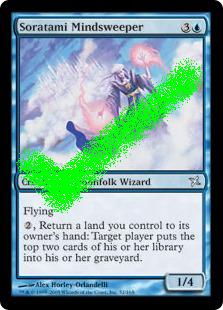
Luckily, several repeatable mill effects have been printed at uncommon. Most recently we've been given Hedron Crab, though the strongest have proven to be Soratami Mindsweeper and Millstone (which was uncommon in Antiquities conveniently enough).
My inclination was also to have mill cards be relevant to decks other than a dedicated mill deck. Sometimes nobody will draft Esper control, and in those cases I wanted mill cards to still have a chance at inclusion. My worries were assuaged when a mostly-green ramp deck Enslaved an opposing Soratami Mindsweeper and proceeded to win with it, demonstrating a more general viability for mill.
I also made a point to crank up the number of graveyard-matters cards, both as a defense against mill and as a possible incentive to mill yourself. A high density of unearth, flashback, and threshold cards could plausibly motivate a blue/green deck to add Hedron Crab in the hopes of flashing back an early Roar of the Wurm. This may never happen, but it was no loss to add these cards to the cube; those themes are popular already.
The success of the mill deck has inclined me not only to keep it, but also to make choices for the rest of my cube with respect to how they would work for or against a mill deck, just as I do for my other archetypes. For example, when possible, I'm including targeted draw effects. Cephalid Broker and Etched Oracle are both scary when your opponent has a dwindling library. I also upped the number of Walls, especially ones that are hard for aggro to deal with, to attempt to make that matchup less hopeless for mill.
Another thing that makes Johnny happy is just having more text on a card. Activated abilities in particular are winners. The more a card does, the more likely it is that Johnny can come up with something silly to do with it. One very inventive drafter of mine decided, for example, to just draft a deck full of tappers, untappers, and pingers. He also threw in such hijinks as Mistmeadow Witch plus Riftwing Cloudskate. His deck was funny, but also proved to be quite strong. I'd mark that as a success.
Timmy Time
You'd expect Timmy to be easier to cater to than Johnny. He just likes big numbers, right?
Preexisting in my cube had been some framework for a ramp deck. The five storage lands supplement plenty of heavy duty fixing. Ramp even gets Joraga Treespeaker, which is on a short list of contenders for the best one-drop in my cube. The problem had been that at uncommon there's not much to ramp into. Flame Wave is impressive, but only if you can drop something huge to win after you play it.
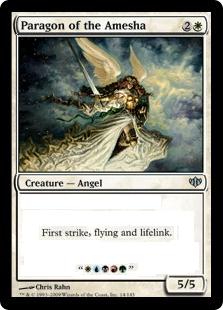
seriously
Sadly, the Pathrazer proved to not be cubeworthy; he was just barely playable as a sideboard card in ramp against a slow mill deck. Eleven is just too much. But the rest of the crew has shown itself to be strong.
Furthermore, I've tried to add more incentive to play additional colors. The only real enemy-colored fixing available at uncommon are the shard lands, so playing more than two or three colors is a chore. Fusion Elemental has long been in the cube, as has Etched Oracle, but they're just not enough motivation.
The obvious additions which I had previously overlooked are Dragonsoul Knight and Paragon of the Amesha. An aggressive deck could play them but never would be excited to do so (and as a result won't pick them early). In ramp, however, they are formidable. Once active, either of these cards will end a game quickly. I've supplemented them with a few "build your own dragon" cards like Zephid's Embrace. They're Auras so they're automatically terrible, but if nothing else they're terrible cards that need to be answered immediately or they will outright win a game. They've also allowed me to remove some of the dorky equipment: cards that are probably stronger but undeniably more boring.
Finally, I tried adding a Sliver subtheme. At one time I had ten of them in the cube. It was somewhat successful, but eventually not correct.
Now hold on. I know what you're thinking: "That's awful." But hear me out. Given the power level of my cube, there are a handful of Slivers that are squarely playable. Acidic Sliver is no Bituminous Blast, of course, but he didn't replace it. He replaced Grief Tyrant. Necrotic Sliver and Cautery Sliver went in for the always unimpressive Orzhov Guildmage and Boros Guildmage.
No power hitters were removed for Slivers; each Sliver replaced a card that I found to be disappointing, and each of the Slivers was, in theory, playable by itself. I was hoping that things would get out of hand if someone ended up with all of them.
There were a few drafts where nobody tried it. Eager to know if they were worth it, I secretly asked one of my strongest drafters to force the archetype. He did. It was not good.
A few Slivers together are fine. Once in a while you'll get a relevant interaction. But as it turns out, a deck with a lot of Slivers is just a bad deck. The bulk of the Slivers in the cube were color intensive two-drops spread across all five colors. That is, the more Slivers are in the deck, the more fragile the mana base must be, and the less likely it is that the player will be able to play the ones in his hand. I was unsatisfied.
Some of the Slivers will stay. Vindicate Sliver is fine by itself. My cube is a bit short on answers to artifacts and enchantments but plays nicely with 187 effects, so Harmonic Sliver is still around as well. But others, which are just two drops that are difficult to cast, are gone.
Tweaking Responsibly
I've talked a lot about what I've added but less about what I've removed. Let's discuss that. In contrast to many cubes, I keep mine at exactly 360 cards. That's just enough for an eight-player draft.
The appeal of having a slightly larger cube is that your players can't bank on seeing a single card. In a 360-card cube you can force draft the Oath of Druids deck even if you don't open it (assuming it's a late enough pick that you'll see it when it does get opened). In a 400-card cube you can't. Oath might not be in the pool being drafted.
I've heard tell of cubes much larger than 360 cards. I view them with skepticism. You add some variety, sure, but you're also widening the power gap between the best cards the cube and the worst. That's not even mentioning the shuffling. Shuffling 360 cards is a pain; I have no interest in dealing with twice that many. If there comes a time when my drafters fall into the same routines every time, I may increase the size of my cube. Perhaps I'll bring it up to 405, just to keep it a multiple of 45. However, so far I have not felt compelled to do so.
The appeal of a minimally sized cube if that it allows me to keep the power level quite uniform.
Consider a powered cube. Realistically, if you open Sol Ring, you take it. It doesn't even matter what else is in the pack. The same is true of Fireball in M11, even if it's pack three and you're not in red. There are rare (and mythic) exceptions, but you know what I mean. My cube doesn't really work like that. Typically a pack will not have an obvious first pick. Sure, some cards are stronger than others, but your archetype will typically be driven by what you want to play rather than the power level of what you open.
Additionally, if I made the cube any larger I would have to take out the Hondens, which are fun. I like that in an eight player draft you can reliably get all five of them. If the cube grows, that becomes increasingly unlikely, so I keep the cube focused.
There were of course a few easy cuts, cards that I evaluated incorrectly when I added them. One such example is the almost-always-awkward Spitebellows. I also cut down on my previous overabundance of draw spells in blue and burn spells in red. Finally, I've become convinced that supporting one-drop aggro takes up more spots than it's worth. I cut a lot of narrow cards that no other deck cares about.
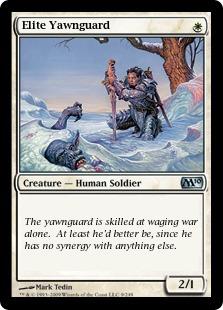
The cards are strong on turn one but they go downhill quickly. To ensure an early play, you want to have a lot of them in your deck, which means you need a lot of them in your cube. Unfortunately, they are completely unplayable to any deck other than one-drop aggro. That's a lot of spots dedicated very narrowly, which I don't like. I'd rather have my aggressive cards be more versatile, like Beastbreaker of Bala Ged or Selesnya Guildmage. That way my players can build their decks for themselves rather than just follow the recipe.
Without hyperaggressive one-drops, aggro typically starts on turn two instead of one, but also gets to play cards that are more interesting. It also leaves room for more flexible one-drops like Mother of Runes and Enclave Cryptologist. Analogously, in a conventional cube I would encourage the inclusion of Scooty-Scoot and Student of Warfare over powerhouse yawnmasters like Savannah Lions.
In blue, which has no hyperaggressive one-drops, I freed up space by toning down the amount of card draw in my cube. Conveniently, this also made blue more interesting to play. I had previously been seduced by the extremely high quality of uncommon card draw to the degree that there was little variety in the color.
If we were to assemble a list of just the 50 (more or less) strongest blue uncommons then that list would probably include Tidings, Fact or Fiction, Opportunity, Jace's Ingenuity, Concentrate, and Thirst for Knowledge. Perilous Research and Careful Consideration are strong as well. And that's just outright draw spells.
I cut back, which meant removing good cards. However, this also allowed blue's other themes to be expressed more strongly. In addition to mill, I was able to increase the presence of tappers, tempo cards, greedy countermagic, and even some quirky cards like Swords to Monkeyshares. And it shows. Blue decks no longer all feel the same.
If blue needed the nicotine patch for card draw, red needed to go to burn spell rehab. Burn is amazing and red has typically unimpressive creatures. As a result, red was becoming exclusively defined as the color that could be splashed for removal. I cut down on the amount of burn, which again meant removing good cards. I replaced them almost entirely with dudes. Some of them are exciting, like Dragonsoul Knight and the Brothers Yamazaki. The last few slots were rougher as I ended up just looking for anything that can turn sideways without being embarrassingly overcosted (Dragon Whelp).
My argument is that even a sub-par creature is more interesting than a giant Fireball to the dome every game. That's not to say burn is dead. The deck still exists. But now there are other strategies as well.
Your Turn
I've probably shared enough. Let's hear your opinions! What quirks in your cube are you most proud of? How did you come up with them? How do your players respond to them?
Comments